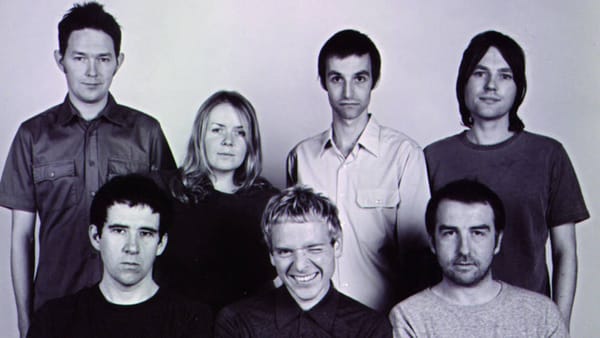The evolution of Arctic Monkeys
Joshua Renken chronicles the continuing reinvention of one of Britain’s best-loved bands

Born and bred in Sheffield, Arctic Monkeys are an English rock band that formed in 2002. Most commonly associated with The Libertines and The Strokes, Arctic Monkeys consist of front man Alex Turner (lead vocals, rhythm guitar, lead guitar), Jamie Cook (lead guitar, rhythm guitar), Nick O’Malley (bass, backing vocals), and Matt Helders (drums, backing vocals). In the nine years since their debut album release, Arctic Monkeys have released four more studio albums, won seven Brit awards, performed during the London Olympic Opening Ceremony and headlined Glastonbury. Twice.
As the principal creative force within the band, Alex Turner brings to the group his distinctive northern accent and fiercely intelligent songwriting. His brilliantly knowing observations manage to capture a scene in a remarkably short amount of time. From the beginning he displayed emotional maturity beyond his years and is deservedly hailed by critics as British indie rock’s finest lyricist.
Arctic Monkeys burst onto the music scene in 2006 with their first LP Whatever People Say I Am, That’s What I’m Not. This album explored themes such as relationships, youth culture, prostitution and nightlife in a way that felt freshly witty and to many, beautiful. Alex Turner’s pace of delivery varies, but many of the slower tracks sound like the drunken slurs of a horny poet in the early hours.
The final track in this album, ‘A Certain Romance’, still epitomises what Arctic Monkeys are capable of. With an immaculate bass riff during the verses, a climactic trickling guitar melody and perceptive vocals throughout, this song describes and reconciles chav subculture with astounding eloquence. Rightly considered to be one of the greatest indie rock songs of all time, ‘A Certain Romance’ is as perfect a pop song as you could ever hope for.
‘Favourite Worst Nightmare’ (2007) went to No. 1 in the charts and carried along a similar vein to their debut album, albeit with more aggression. The raw beats and rapidly delivered lines on tracks like ‘Brianstorm’, ‘Balaclava’ and ‘Old Yellow Bricks’ made for an exhilarating sound that was balanced out by the melancholy, intimate ballads such as ‘505’ and ‘Only Ones Who Know’.
The band’s third album, Humbug, is the most hit and miss of the five. Morose and mysterious in equal measure, Humbug represented a significant shift in Arctic Monkeys’ musical direction. With a much calmer but more challenging sound, this LP separated the band’s listeners into fans who loved them all the more and casual followers who preferred the unpretentious and grittily charming tales of love and nightlife that featured in their first two albums. Third albums are notoriously difficult for bands in the limelight but Turner’s lyrical flair continued to impress. ‘Humbug’ featured fewer catchy hooks than many would have wanted but also included some real pearls. Tracks such as ‘Cornerstone’ and ‘Dance Little Liar’ reassured fans that Arctic Monkeys were here to stay. Four boys had become men.
With _Suck It and See _(2011), Arctic Monkeys had returned to making more accessible and less moody music than they had with Humbug. However, many of Turner’s songs were less interesting than his usual output and felt hollow by comparison. This small dip in lyrical form was most evident in ‘Brick by Brick’, which is perhaps the weakest track Arctic Monkeys have ever released despite the strong instrumentals. ‘Piledriver Waltz’ takes you on a sublime journey of soft psychedelic rock with inventive allegorical lyrics, and ‘Love is a Laserquest’, ‘Suck It and See’ and ‘That’s Where You’re Wrong’ serve as a strong trifecta to conclude the album. This fourth album showed small changes in the band’s sound, but in terms of development Suck It and See is Arctic Monkeys’ least significant LP of the five.
The band’s most recent creation, AM (2013), marks the second metamorphosis of Arctic Monkeys. This hip-hop influenced album features an impressive variety of songs ranging from the thunderous ‘Do I Wanna Know?’ to the gracefully ironic ballad ‘No. 1 Party Anthem’. AM represents a return to top form for the band, where big riffs and catchy hooks accompany mindfully crafted, penetrating lyrics. With this LP Arctic Monkeys have also made history as the only independent group whose first five albums have all gone to the top of the charts.
It would be ridiculous for Arctic Monkeys to still be writing the kind of songs that they produced at the beginning of their career, simply because the band’s circumstances have changed so much. They no longer live the life of a plucky underground band skulking around Sheffield. Now it’s all private jets and courting supermodels in America. In five short years Alex Turner has swapped jumpers and long hair for leather jackets, sunglasses and a slicked back quiff in a transition every bit as seamless as the band’s departure from their previous albums. Masters of reinvention, Arctic Monkeys cannot easily be pigeonholed. They are still maturing and refining their sound; who knows what they’ll come up with next. Bring on album number six.









